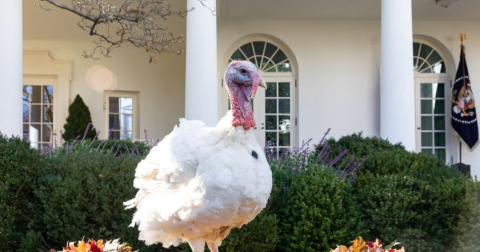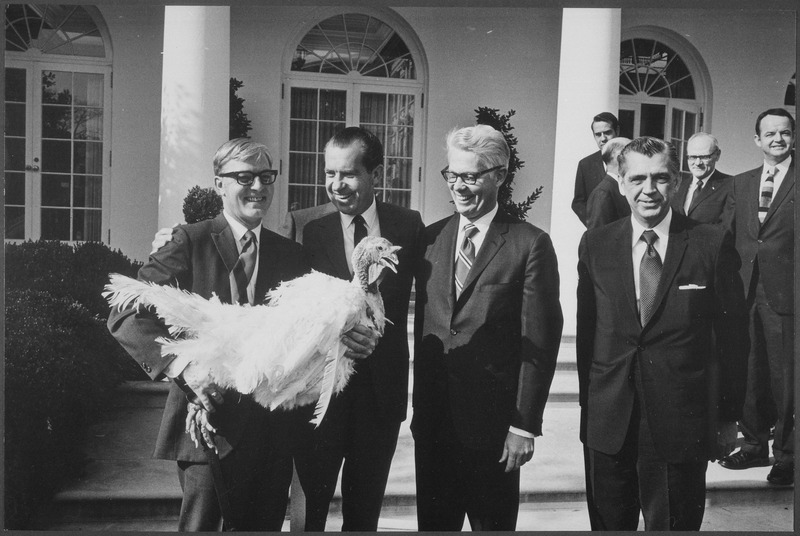Solutions
West Hollywood Committed to Plant-Based Food. Here’s What That Looks Like So Far
Climate•6 min read
Reported
The seemingly humane tradition, which can be traced back to meat lobbyists, correlates with a rise in turkey consumption.


Words by Björn Ólafsson
Every November in the United States, the White House issues a pardon for a turkey — the only time presidential pardons are issued for non-humans. The All-American practice of the Thanksgiving turkey pardon has a long history, and is firmly embedded in pop culture, appearing in TV shows and movies like “Red, White and Royal Blue,” “The West Wing,” and “Rick and Morty.” But when you stop to think about it, it’s weird — why go through this massive effort to save one animal, when 45 million other turkeys will be eaten on Thanksgiving just a few days later?
The White House ceremony is perhaps the most famous confrontation of our strange relationship with meat and animals in American life. Delving into the even stranger history of the turkey pardon tradition can help explain our eating habits just a bit better.
The turkey pardon has its roots in the late 19th century when Tad Lincoln, the rambunctious child of President Abraham Lincoln, grew emotionally attached to an ill-fated turkey. The bird was supposed to be Christmas dinner — but instead became Jack, the beloved pet of Tad, prone to waddling around his human friend through the White House.
On Christmas Eve, it was time for Jack to be eaten, but Tad refused: “He’s a good turkey,” he told his father, “I don’t want him killed.”
Tad Lincoln appears to have anthropomorphized Jack on multiple occasions. When Honest Abe jokingly asked if the bird could vote, Tad said no — because he was too young, not because he was non-human.
While the story of Jack the turkey was the first time a White House turkey’s life was spared, the tradition of a presidential turkey pardon was not yet cemented. In fact, the fate of presidential turkeys got worse before it got better. In the early twentieth century, a lobbying group called the National Turkey Federation (NTF) started donating turkeys to the White House as a marketing move.
The timing was purposeful — Truman had previously been promoting “Meatless Tuesdays” and “Poultryless Thursdays” in 1947. The program was entirely voluntary, with the government providing recipes and encouragement to citizens to reduce meat consumption to save food during the war. Powerful meat lobbies protested, in part through donating turkeys and hens to the White House. The backlash was so swift that the Poultryless Thursday campaign only lasted a few months.
Over the years, other presidents began indicating discomfort with the practice of killing the Thanksgiving turkey in front of them. First, in 1963, President Kennedy decided not to eat the first turkey from the Turkey Federation (who was forced to wear a sign around her neck saying “Good Eating, Mr. President”). Kennedy announced he wouldn’t eat the specific turkey for Thanksgiving, remarking, “let’s keep him going.” The newspapers decreed it a “pardon” — even though Kennedy didn’t himself use that word. It’s not perfectly clear why President Kennedy made this decision — and ironically, he was assassinated only three days later.
Presidents Carter and Nixon also spared turkeys, although in a different manner. Their wives, Rosalynn and Patricia, respectively, sent the turkeys to sanctuaries and zoos.

But it was President Reagan who first used the word “pardon” in relation to turkeys in 1987. The move doesn’t seem to have arisen from a love of animals: Reagan was in the midst of the Iran-Contra scandal, and was being bombarded with press questions about whether he would pardon his staff who’d facilitated the secret arms deal. Appearing to deflect from the scandal, Reagan said he would pardon a Thanksgiving turkey.
And finally, President George H. W. Bush sealed the tradition, announcing an “official” presidential pardon to a lucky bird every year starting in 1989. The first turkey pardon ceremony was attended by children as well, who petted the bird with joy, just as Tad Lincoln did a century before.
Nowadays, the turkey pardon is a mainstay of the White House press events. The pardoned turkeys have their own punny nicknames — and sometimes even social media accounts.
The turkeys are usually raised in the home state of the NTF Chairman and selected to ensure they are good-looking representatives of their ill-fated brethren. They are also trained to “behave” well in loud and crowded spaces. Two birds are flown to Washington D.C. — the star, and the alternate. But if both birds are lucky, both take part in the ceremony and receive a pardon, depending on the president.
During the ceremony, these turkeys likely suffer from anxiety and fear due to the flashing lights, unfamiliar faces and cacophonous sound. Despite popular belief, turkeys aren’t unintelligent at all, with large brains and highly-developed social skills; being plopped in an unfamiliar environment, away from their friends and family, can be extremely taxing.
Unfortunately, due to decades of selective breeding by the turkey industry, these lucky birds often suffer from disease a short while after Americans’ Thanksgiving plates have been placed back in the cupboard. Most only live a few months past their pardon.
In recent years, the pardoned turkeys are living longer, sometimes even a few years. The two turkeys pardoned last year, Chocolate and Chip, now reside in NC State’s Talley Turkey Education Unit, where they continue to serve as symbols for normalizing eating their kind. This time, they are teaching up-and-coming animal farmers the “importance of modern animal agriculture,” and educating children about farm life.
It is common for the industrial animal farming sector to use specific animals as propaganda pieces, similar to Chocolate and Chip. Farm Days, which are sanitized farm-like experiences for children, are strategies designed to make the animal agriculture industry seem more transparent. Similar to how only the handsome and stress-free turkeys are paraded in front of presidents, the public only glimpses certain aspects of animal farming in their tours.
Unfortunately, the reality is that an estimated 99.8 percent of all turkeys are factory farmed, and they are bred in larger numbers than the previous decade. And while the select few pardoned turkeys have a few months or years more to live, their species is being consumed in far larger quantities than ever before, driven by massive increases in turkey consumption in the 1990s and 1980s.
In other words, oddly, the formalization of the turkey pardon in 1987 appears to directly correlate with a rise in turkey consumption in the United States. Instead of eliciting compassion for their species, the pardoned turkeys seem to serve more as a big commercial for the tradition of eating a Thanksgiving turkey itself.
In many ways, the history of the turkey pardon reflects our strange and paradoxical relationship to animals. It’s no wonder that a ceremonial act of mercy can be traced back to a child — research shows that children are more likely to say animals shouldn’t be eaten, and less likely to believe that humans are superior to animals.
Some social scientists argue that indoctrination and human biases chip away at this innate animal sympathy over time. Some philosophers have argued that it’s wrong for parents to force their otherwise meat-averse children into eating animal products, calling it an act of corruption. Children like Tad, who have yet to be fully socialized into eating animals, are far more likely to want to spare an animal’s life.
Yet in the modern day, the tradition reveals another deep contradiction in America’s food system. Animals raised for food are often seen as individually worthy of recognition or respect — think of real animals like influencer Esther the pig, or fictional characters like Okja and Babe. Conceptualizing millions of individual animals is nearly impossible, so humans must often empathize with a single animal spared from slaughter — that’s why people who have strong bonds with a pet are more likely to avoid meat.
Many people might be surprised to learn that the turkey pardon started out as a lobbying effort from the turkey federation — one itself spurred in reaction to a Meatless Tuesday campaign. Its evolution into a humane ceremony (at least, symbolically humane) is likely not what the turkey industry would have predicted. However, collective turkey consumption has only increased from there — their gambit worked. The American desire to see one turkey pardoned — while still eating another for dinner — is a perfect example of the cognitive dissonance required for most people to keep eating animals.